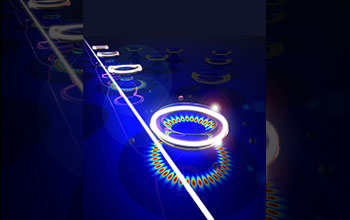Multimedia Gallery
Optical 'whispering galleries'
"Whispering gallery" sensors can detect a single nanoparticle. These particles disturb light waves in fiber-taper coupled microresonators.
More about this image
The geometry of some large rooms with domed ceilings can magnify softly spoken sounds. The effect makes whispers easily heard by listeners outside of normal earshot. Two famous examples of such places are New York's Grand Central Terminal and St. Paul's Cathedral in London. This is called a "whispering gallery," and U.S. National Science Foundation-supported engineers are using the science behind this phenomenon to detect airborne viruses, only instead of sound waves they use light.
Researchers have created an optical whispering gallery that uses light to interact with a single particle over thousands to millions of times to significantly enhance interactions between the light and the sub-wavelength particle. The unprecedented sensitivity of this tiny, on-chip device proves to be a big breakthrough in the optical sensing of airborne particles and viruses.
The work was supported by NSF grant ECCS 0954941.
Learn more about this research in the Washington University news story Tiny sensor takes measure of nanoparticles.(Date of Image: 2010)
Credit: Nano/Micro Photonics Laboratory, Electrical and Systems Engineering Department, Washington University, Saint Louis
Images and other media in the National Science Foundation Multimedia Gallery are available for use in print and electronic material by NSF employees, members of the media, university staff, teachers and the general public. All media in the gallery are intended for personal, educational and nonprofit/non-commercial use only.
Images credited to the National Science Foundation, a federal agency, are in the public domain. The images were created by employees of the United States Government as part of their official duties or prepared by contractors as "works for hire" for NSF. You may freely use NSF-credited images and, at your discretion, credit NSF with a "Courtesy: National Science Foundation" notation.
Additional information about general usage can be found in Conditions.
Also Available:
Download the high-resolution JPG version of the image. (1.8 MB)
Use your mouse to right-click (Mac users may need to Ctrl-click) the link above and choose the option that will save the file or target to your computer.



 All images in this series
All images in this series